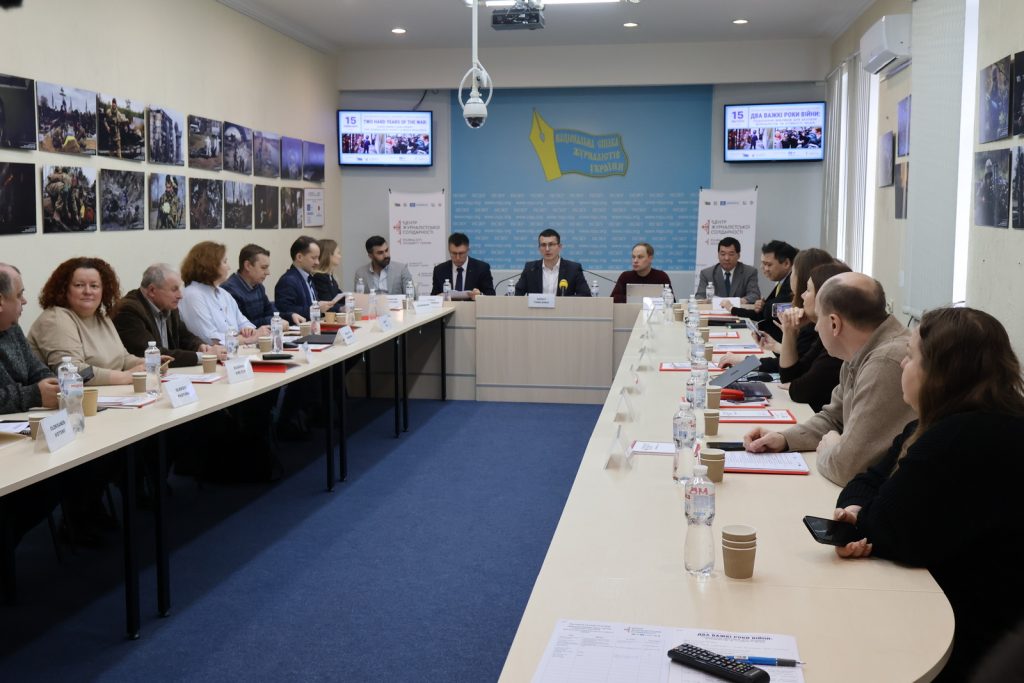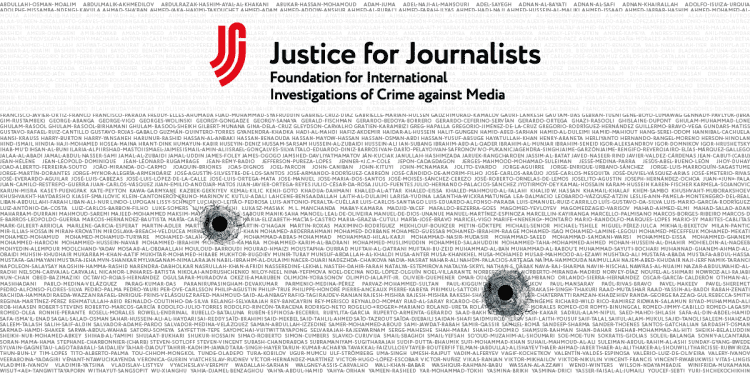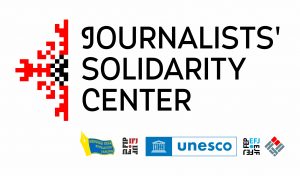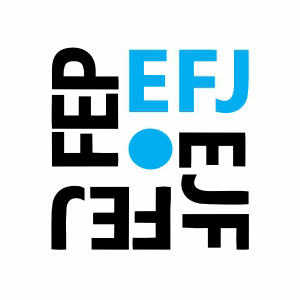After Russia’s full-scale invasion of Ukraine two years ago, thousands of Ukrainian journalists found themselves becoming frontline correspondents almost overnight. Dozens of foreign journalists also arrived in the country to report on the war. Without these professional and citizen reporters the world would not have been able to understand the extent of the unfolding catastrophe.
However, a high price has already been paid. According to the National Union of Journalists, at least 16 media workers have died while performing their professional duties, 9 media workers have died as a result of collateral damage and at least 54 journalists have died while serving in the armed forces.
The London-based charity Justice for Journalists Foundation (JFJ), in partnership with the National Union of Journalists in Ukraine, and with financial support issued by UNESCO, has been collecting open-source evidence and satellite imagery of attacks on media workers during the war in order to create safety recommendations, risk assessments and HEFAT training for journalists heading to the war zone.
Over the course of the project, we have obtained and processed information about 35 instances of both fatal and non-fatal attacks against media workers in Ukraine, involving at least 55 journalists from countries including Ukraine, Turkey, Czech Republic, the USA, Russia, Ireland, the UK, Italy, France, Japan, Denmark, Germany, Switzerland, Sweden, Portugal, and Lithuania.
Verified data confirms that 12 media workers have died as a result of enemy shelling. This includes six foreign journalists: Arman Soldin, Frédéric Leclerc-Imhoff, Mantas Kvedaravičius, Pierre Zakrzewski, Oksana Baulina, Brent Renault; and four Ukrainian journalists: Oleksandra Kuvshinova, Maks Levin, Bohdan Bitik and Yevheniy Sakun.
Additionally, at least four Ukrainian media workers were tortured and killed in Russian-occupied territories: Yevgeny Bal, Zoreslav Zamoysky, Roman Nezhyborets and photojournalist Ihor Hudenko.
2024 has already seen two journalists and one fixer for the Turkish news agency Anadolu injured by Russian shelling on the Park Hotel in Kharkiv. Additionally, a Radio Free Europe/Radio Liberty camera crew came under mortar fire while working on the front line.
Having analysed the collected data and interviewed the victims and witnesses of these attacks, JFJ has identified the key risks journalists were facing while reporting from the war zone and developed preliminary safety recommendations for media workers covering the war in Ukraine. These recommendations do not cover all aspects of journalists’ safety, but will be useful for those who are reporting from Ukraine.
- COMPLETE A HEFAT TRAINING COURSE BEFORE TRAVELLING TO THE WAR ZONE
Completing a hostile environment and first aid training course is crucial before travelling to the conflict zone. Skills developed during this training will help media workers learn more about the basics of safety; how to conduct a risk assessment; how to act in dangerous situations, and potentially save their fellow crew members’ lives. Even if you are a well-trained journalist and have a lot of experience covering conflicts, because all wars are unique it is essential to refresh these skills every year.
- CONDUCT RISK ASSESSMENT BEFORE TRAVELLING
Conducting preliminary risk assessment and developing a specific risk protocol prior to travelling to the war zone should be mandatory for all media workers in conflict zones. It is vital to understand the specificities of the regional context, including tactics, combat uniforms and weapons used by both sides.
While planning the route, informing your colleagues or management about your whereabouts is key. Remember the safety basics, i.e., avoid using the same entrance and exit roads while planning your route.
- CONDUCT LOCAL RECONNAISSANCE
While on assignment, keep in touch with locals to keep up to date with what is happening in the area you plan on travelling to. Do not rely on outdated information, even if it is just a couple of days old. In the area of direct combat operations, get new information as often as possible.
When visiting an unknown area, conduct a preliminary terrain analysis. Never rely on technology, learn to read physical maps, and navigate the terrain without the help of gadgets whose signals can be tracked.
- CHOOSE ACCOMMODATION CAREFULLY
Evidence shows that the Russian military targets hotels favoured by international and Ukrainian media representatives. When choosing your accommodation, try to avoid hotels that could become a target of such an attack. Avoid staying close to administrative buildings, railway junctions, warehouses and other strategic objects that can be targeted. The best option, when possible, is to rent a flat discreetly. Regular safety considerations should not be forgotten: the building should not be tall and should have an easy escape route in the case of attack. Familiarise yourself with all the entrances and emergency exits in advance.
- PROTECTIVE GEAR
A journalist must be fully equipped with protective gear on the frontline, including a bulletproof vest and protective helmet with the inscription “PRESS”. Avoid wearing military-style clothing as there is a significant risk of being confused with military personnel.
- MARK AND PREPARE YOUR VEHICLE
Marking the car with a “PRESS” inscription is vital. Do not go for options like “TV” as in Ukraine it might be read as “V”, which is used by the Russian Armed Forces. In case of a drone attack, the usual “PRESS” sign can be hardly visible. Consider using polyvinyl magnets, which are easy to apply and remove. The marking should be large and visible on all sides of the car: on the front, on both sides, and on the roof.
To avoid being identified as military personnel and becoming a target, avoid marking your car with any signs associated with the military (such as yellow tape, white crosses, etc.), even if this is suggested by the local armed forces.
Ensure that the car is in good condition and has spare wheels, as well as other necessary tools for emergency repairs.
- BEWARE OF SWITCHING CARS
Make sure your vehicle always has clear “PRESS” markings. Try to avoid changing vehicles, and do not get in a car with unknown people or military personnel, who can be targeted by the opposing military. Be careful when using taxis to travel to dangerous areas. Ensure that your driver fully understands the risks; will not abandon the crew in case of an attack; and has the necessary spare parts for the vehicle in case of an emergency.
- HAVE ADDITIONAL CHANNELS OF COMMUNICATION
Never rely on technology while in the conflict zone. If you are a journalist working for a media outlet, try to obtain a satellite phone. This can often be costly for freelance journalists who can use a cheaper alternative, like a satellite navigator. Always have a backup plan if the technology fails.
Remember that both sides use electronic warfare equipment near the combat zone, while mobile gadgets may not work properly or provide unreliable GPS navigation data. Avoid using your GPS in a combat zone unless you have no other means to determine your location.

CONCLUSION
It is important to note that while some physical attacks against media workers become public, not all cases are known. In particular, this concerns journalists working for smaller regional publications, freelancers, and fixers. While journalists working for more prominent media outlets routinely receive essential training prior to their trips to war zones, and have both access to the necessary equipment and support, the safety of freelancers and local team members is in their own hands. They often have to deal with costly expenses alone, while also assessing and mitigating their professional risks.
Justice for Journalists Foundation and its partners aim to increase the safety of media workers in Ukraine by creating and maintaining a secure database of evidence related to those attacks and ensuring media workers are aware of their risk mitigation options.
For the first time, these key recommendations were presented during the international expert discussion “Two hard years of the war: overcoming challenges for journalists` safety and media resilience”, which was held on February 15, 2024 at the initiative of the National Union of Journalists of Ukraine (NUJU) and the Ministry of Culture and Information Policy of Ukraine under the patronage of the National Commission of Ukraine for UNESCO.

 THE NATIONAL UNION OF
JOURNALISTS OF UKRAINE
THE NATIONAL UNION OF
JOURNALISTS OF UKRAINE









![International Media Organizations: peace plan mustn’t envision amnesty for crimes against journalists 11 Ukrainian flag on Independence Square [Maidan Nezalezhnosti] in Kyiv, Ukraine (archive image). EPA-EFE / Oleh Petrasiuk](https://nuju.org.ua/wp-content/uploads/2025/12/maidan-flag-yezhak-2022-120x86.jpg)






Discussion about this post